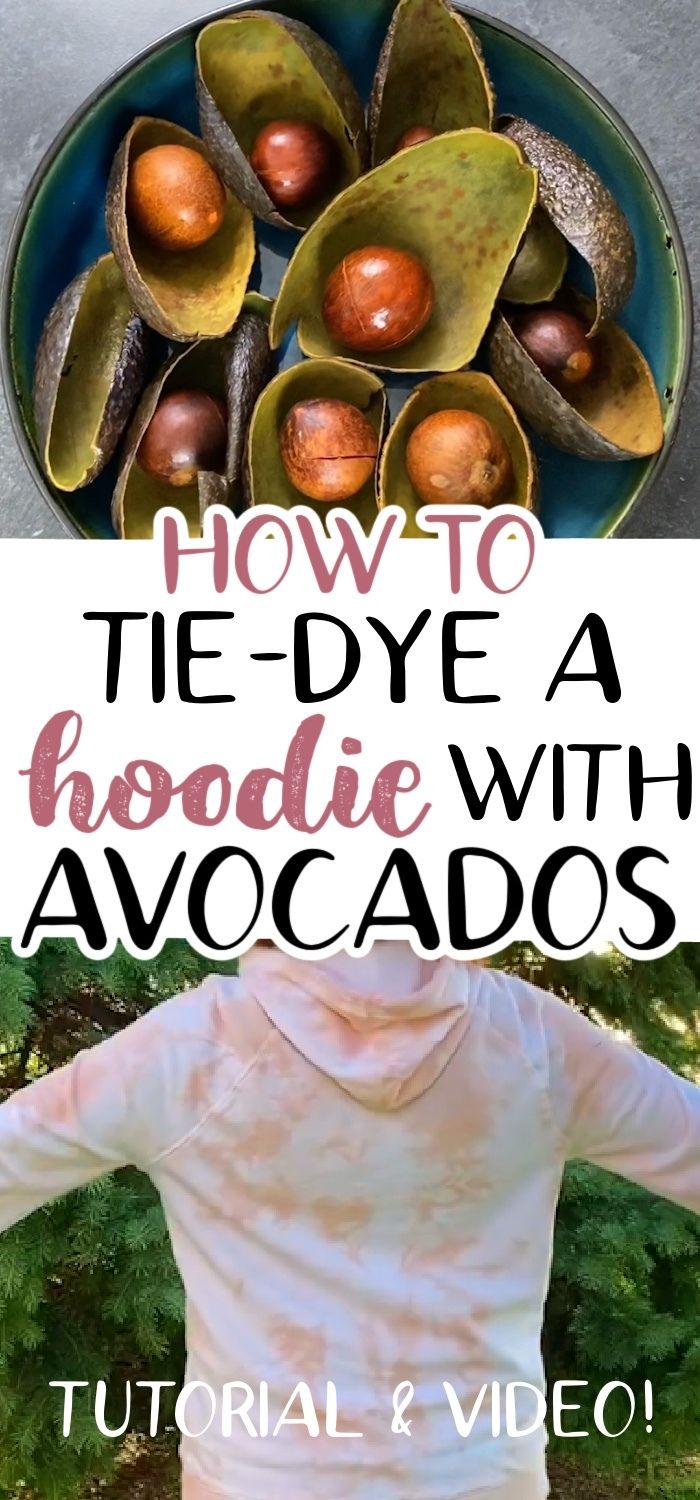How to Tie Dye a Hoodie with Avocado Pits (Tutorial + Video)
Have you ever wondered how to tie dye a hoodie with avocados? I’ll show you how to tie dye a cotton hoodie with avocado pits and peels in this step by step tutorial and video!
Want to remember this? Post this Natural Avocado Tie Dye Hoodie tutorial to your favorite DIY Pinterest board!

(This post may contain affiliate links. If you click one and make a purchase, I may receive a small commission at no extra cost to you. Read the disclaimer here. Thank you for your support!)
Despite their normal green hue, the peels and pits of avocados can be used to create an absolutely gorgeous earthy pink dye that you can use to dye natural fabrics and fibers.
The resulting color is so pretty, but I’ve found it’s really hard to take a good picture that does it justice.
It tends to show up a bit brownish in photos, but in real life it’s really lovely. I’ve seen it called “millennial pink” since the color has been so popular with my generation. It’s one of my favorite natural dyes!
I’ve dyed some awesomely squishy wool yarn with avocados in the past, and I also played around with dyeing raw silk fabric. Both turned out AMAZING, btw.
Tie dye is super popular right now, and a lot of people are getting more interested in natural dye techniques (myself included). I decided to give tie dyeing with avocados a try and see if it can be done.

So, can you dye clothes with avocados?
Spoiler alert: Yes, it works!
You can totally tie dye a white 100% cotton sweatshirt with avocados. Blended fabrics like cotton/poly blends might not work as well, but a natural fiber like cotton and wool work beautifully with avocado dye.
There are lots of fun natural botanical dyes you can make! Some other popular natural dye materials are onion skins, beets, turmeric, and even tea and coffee.
Keep scrolling and I’ll show you how to make a beautiful dye with avocado pits and peels.

Before we get started with the dyeing process, we need to talk about mordants.
What is a mordant?
A mordant is a chemical additive that binds to the fiber and the dye particles and basically attaches them together.
When you’re dyeing certain fibers, especially plant based fibers like cotton, a mordant will help you get a richer color that will stay color-fast for much longer than if you dye it without a mordant.
Does avocado dye need a mordant?
When you’re dyeing protein (animal) fibers, like wool or silk, you won’t need a mordant for avocado dye.
The avocado skins and pits have natural tannins in them that work well as a mordant without any additional steps.
When you’re dyeing plant based (cellulose) fibers with avocado (like the cotton sweatshirt in this tutorial), using a mordant will help the dye adhere to the cotton fibers. That way your sweatshirt will stay color-fast and awesome for much longer!
What mordant is best for vegetable dyes?
There are many different mordants you can use in natural dyeing.
A common mordant for avocado dye is Alum. You can usually find it in the canning section at your local grocery store. Sometimes people recommend using vinegar as a mordant as well.
For this project, I used Soy milk as a mordant. Yep, good old soy milk from the grocery store!
During my researching, I came across this helpful info about using soy milk as a mordant for avocado dyeing. (Unfortunately this site isn’t working anymore.)
I felt a little bit more comfortable using soy milk instead of any unfamiliar chemicals (even though Alum is totally safe).
I’ll show you the process I followed down below in the tutorial.
Do I need soda ash to tie dye with avocados?
No, you won’t need soda ash for this tie dye project.
Wondering what soda ash is, anyway? When you’re doing conventional tie dye, soda ash is used to raise the pH balance of the dye. Doing so helps the dye adhere to the fabric better and results in brighter colors.
The soy milk mordant we’re using will help the avocado dye adhere to the cotton fabric.
Supplies You’ll Need to Tie Dye a Hoodie with Avocados
- 100% cotton sweatshirt
- 5 to 7 avocados worth of skins and pits (I saved mine in the freezer for several weeks)
- Soy milk
- a large stock pot with a lid
- slotted spoon or skimmer
- rubber bands
- good old tap water
How to Tie Dye a Hoodie with Avocados // Tutorial
Step 1: Soy milk mordant
First, wash your sweatshirt with hot water and unscented laundry detergent. Take it out of the washing machine after the spin cycle and set it aside while you mix up the mordant.
In a large pot (I used the same 5 gallon pot I later used to heat the dye), mix up 1 part soy milk to 5 parts tap water. You want it to be deep enough to submerge your sweatshirt.

I ended up using about half of the half gallon of soy milk I bought, so roughly 4 cups soy milk and 20 cups of water.
Stick the lid on the pot and put it in a cold place for at least 24 hours. It was pretty cold out, so I put mine in the garage to save fridge space. If it’s warmer where you are, you’ll want to make some room in the fridge.

Also, I originally intended to leave it for 24 hours, but as per usual, I forgot about it. I don’t think it makes a difference but I figured leaving it for longer couldn’t hurt. Mine ended up soaking for about 48 hours.
After it’s done soaking, wring out as much of the mordant as you can by hand. Then, throw it in the washing machine on the spin cycle (no rinsing). When it’s done spinning, hang it on a hanger and it needs to cure for a week before you dye it.
Yes, this seems a little weird, but it’ll help the dye adhere to the fabric better so just go with it. I left mine for two weeks before I finally got around to tie dyeing it, and it was totally fine… just a little crunchy.
Step 2: Prepping the avocado dye
First, you’ll want to scrape out any leftover avocado fleshy bits from the skins and pits. It makes the water all gross and murky if you don’t.
Mine were frozen since I’d been saving them up in a zip top bag in my freezer, but I just ran them under the tap and used a spoon to really scrape the skins clean. I scrubbed the pits with a wet washcloth until they were nice and clean as well.

Now, put the pits and skins in the pot and add enough water until your sweatshirt will be fully immersed. My 5 gallon pot was about 1/3 of the way full.
Put your dye pot on the stove, put the lid on, and turn the heat to low. You want it to get hot but not come to a boil.

You’ll want to leave it on the heat for between 1.5 and 3 hours. Mine was ready after 1.5.
Step 3: Prepping the hoodie
While all that’s happening, you need to grab your slightly stiff mordant-ed sweatshirt and throw it in the washing machine for a rinse and spin with WATER ONLY. No soap or detergent.
Now you can figure out how you want to fold or wad it up for the tie dye effect. I was originally going to do the whole twirl effect, but at the last minute I decided I liked the crinkle effect so I wadded it up as evenly as possible and secured it with some rubber bands.



Step 4: Time to tie Dye the hoodie with avocados!
Once your dye bath looks nice and dark, turn the heat off and fish all the skins and pits out of the water with a slotted spoon.

Really make an effort to get all the pieces out. If you leave any avocado bits in while the fabric soaks, it can leave weird irregular spots on your sweatshirt.
Carefully submerge your bundled up hoodie down into the avocado dye. Mine mostly stayed under but one side wanted to float a little. Just poke it down every once and awhile to make sure it gets evenly dyed.

I let mine sit in the dye for about an hour and a half. I think you could leave it in for up to three hours and possibly get different results and a slightly darker color, but I was too impatient to wait that long.

Step 5: Rinsing and finishing up
Once I was happy with the pink color, I pulled the hoodie out of the dye, put it in a large bowl and brought it up to the bathtub to rinse.

You’ll want to unwrap it and rinse it under cold water until the dye runs clear.
After that, you can run it through the wash with water only (no detergent still!) and dry it. Honestly you might be able to wash it normally the next day, but I waited a week before I used detergent on it just to be safe.
Since then, I’ve washed it twice normally and the color hasn’t faded a bit!

FAQ’s
What kind of avocados work best for dye?
As for the types of avocados, I just went with Hass because that’s what’s available in my local grocery store. They worked great!
How many avocado seeds do you need to dye?
You’ll need 5 to 7 avocado pits and the peels to go along with them. You could use more if you want to achieve a darker color.
How long will avocado dye last?
In my experience, avocado dyed fabric will have deeper colors and brighter pinks for a long time if you follow a few best practices:
- Use a mordant bath before you dye cellulose fibers like cotton
- It’s a good idea to keep your avocado dyed fabrics away from direct sunlight for prolonged periods of time
- For best results, use a gentle, neutral soap when you wash your naturally dyed fabricsen you wash your naturally dyed fabrics
In Summary
I hope you enjoyed this project and you be making your own tie dye hoodie with avocados!
The color is so fabulous, who’d of thought avocados could have such a pretty color of pink lurking inside?!
If you make one of these, please share a picture on Instagram and tag me @marchingnorth so I can see! I love seeing all of your creations, it seriously makes my day.
Related Posts
- How to Make a Punch Needle Sweatshirt (with FREE printable patterns!)
- DIY Large Macrame Wall Hanging // Tutorial & Video
- How to Crochet a Magically Squishy Rug with Super Bulky Yarn // Tutorial & Video
- “Auda” Mini Macrame Wall Hanging – Free Pattern and Video!
- Easy 3 Arm Spiral Macrame Plant Hanger (Free Pattern + Video!)
- Free DIY Macrame Plant Hanger Pattern (Low Key & Tassel Free!)
- 47 Fun Granny Square Crochet Project Ideas: Easy & Free Patterns!
- DIY Button Snowman Gift Tag Ornaments | Step-by-Step Tutorial!
- DIY Macrame Snowflake Christmas Ornament Tutorial
